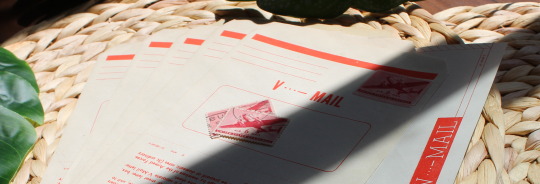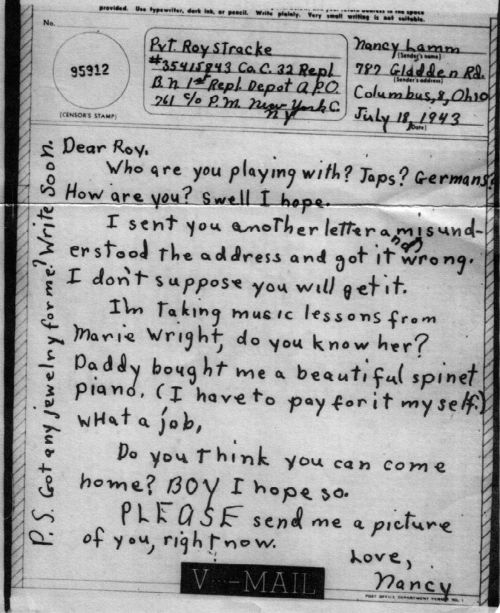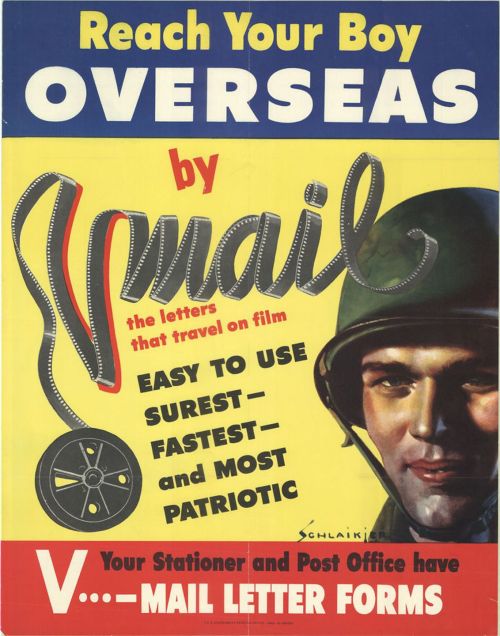#v-mail
V-Mail
Introduction to V-Mail
This is the first is a 2-month long series of posts on the WWII process of V-mail. They are an accompaniment of the Ephemera Club perks for February and March 2022.
What was V-Mail?
V-Mail was a hybrid mail process employed by the US military during WWII (1942-1945). Faced with competing issues of limited cargo space and the need for reliable mail to sustain the moral of troops, the US military adapted a British innovation. Letters would be captured to film, transported in this compressed form, them reprinted at the other end to then be delivered to their destinations. Rather than displacing vital supplies like food and equipment, equally vital mail could now be condensed into small film reels rather than bags-upon-bags of paper mail. Image 1 shows the difference in volume between paper mail and the same volume transferred to film.
How did V-Mail differ from standard paper mail?
Other than the benefit of volume when in transit, V-Mail varied from standard mail in a number of ways.
- Stationery: Unlike standard mail, V-Mail required specific, standardized stationery to work. Image 2 shows a scanned example of this specialized stationery. These could be acquired by civilians at the post office, with the first two sheets each day being free, and the option of purchasing more there or at neighbourhood stores. They were produced by various sanctioned companies. These sheets contained directions on their up, where to write, and how to fold them.
> More on how V-Mail was used later in the series! - Letter Format: With the specialized stationary, writers had to adapt their approach to letter writing. Due to the conversion to film and then re-printing, the letter writer needed to make sure their ink was dark and handwriting of a legible size when reprinted on a smaller paper size. Along with this, for the most part letter could not include any loose items, and lipstick marks were prohibited as they interfered with the machinery.
> More on how V-Mail was used later in the series! - Format for the recipient: Rather than receiving the same physical letter sent by the writer, the recipient instead would receive a printed image of the letter. This re-print would be reproduced at a smaller scale than the original, on photographic paper, then sent on in a new envelope to the intended recipient. Image 4 shows an example of a re-printed letter.
> More on the process of how V-Mail worked later in the series! - Security and Reliability: A big advantage to V-Mail aside from volume in transit was that the process had built-in security and insurance. As part of the filming process, letters went through censorship to remove information that could jeopardize the war-effort. Along side this, the process of capturing the images foiled many espionage efforts. Once transferred to film, the original letters were kept in storage on-site until they received confirmation the film reels had been safely received. This provided a back-up in the event of the reels being lost, damaged, or destroyed in transit.
>More on the process of how V-Mail worked later in the series!
More on this topic to come — Follow @steve-rogers-new-york to seen new posts as they are released.
If you want more in the topic, my full research notes on all topics are available for all $3+ Patreonpatrons!
Images
“V-Mail is Speed Mail” Promotional image | Source
V-Mail stationery scan | SRNY Personal Collection
Re-printed V-Mail letter, July 18 1943 | Source
“Reach Your Boy Overseas” Promotional poster | Source
Volume comparison with clerk, NY embarkment center | Source

This post series is thanks to my fantastic Patreon supports at the Ephemera Club level. For February and March 2021, the curated perks will be built around the theme of V-Mail. February will include a genuine sheet of V-Mail stationery (unused), and March will include a genuine re-printed letter received at the end of the process. If you would like to receive these and other cool items like them each month, head over to the Patreon. Spaces are limited!


[Support SRNY through PatreonandKo-Fi]
And join us onDiscordfor fun conversation!
I also have an Etsywith up-cycled nerdy crafts
Post link




